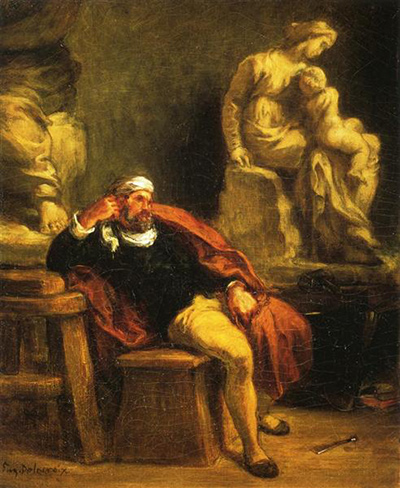Eugene Delacroix uses this painting Michelangelo in his Studio to associate with Michelangelo, an artist he greatly wanted to identify with; this brings us to identify a symbol of his predicament as an artist not well understood.
In the painting, Michelangelo is in a red scarf, one thing for which Eugene Delacroix was famous.
Eugene Delacroix is the last of the great Renaissance painters, and he seems to emanate from the lineage that traces back to Michelangelo and whose prodigal son Flemish painter Peter Paul Rubens. In fact, in more than one sentiments in his journal, Eugene Delacroix lays claims to this heritage en-rooted in this lineage.
The familiarity that surrounds the work of Michelangelo has elevated and exalted every generation of painters that came after Eugene Delacroix's time.
While talking about Michelangelo, Delacroix exalts him as the force behind the tradition he attributes the depiction of tender sentiments that all lies outside the bounds of the ingenuity displayed by Michelangelo.
In his loyalty to the heritage, the explicitly painted Michelangelo in his studio painting explicitly describes the love he had for the lineage. Similarly, in his work The Last Judgement in Sistine Chapel he consulted his taste for terribilitas.
Further, Delacroix describes himself in an effort to render homage to Michelangelo. Eugene Delacroix insists that the ingenuity that is attributed to Michelangelo is probably the closest kin to his which facilitated him to imagine and paint Michelangelo in his studio between 1849 and 1850.
Similar to Michelangelo, Eugene Delacroix greatly inclined to terribilitas, and his imagination also dwells on the images of dread.
There is this idea that a person can only explicitly understand nature, free from their community. Salvation and peace is only said to come from understanding oneself but not through political movements. This was an important ideology that propelled Romanticism.
Eugene Delacroix, just like other Romantic painters, were involved in a complex philosophical movement that consisted intellectual, literary, and visual arts.
Eugene Delacroix modified Romanticism, including some influences of great masters like Michelangelo and the Flemish painter Rubens. He came up with his style of depicting suffering and pain through the coloured canvases.




